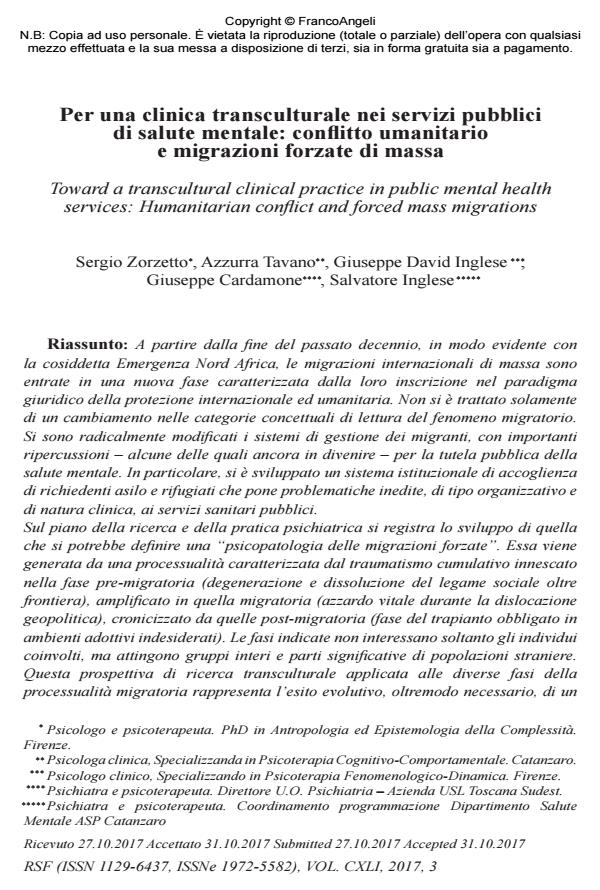Per una clinica transculturale nei servizi pubblici di salute mentale: conflitto umanitario e migrazioni forzate di massa
Titolo Rivista RIVISTA SPERIMENTALE DI FRENIATRIA
Autori/Curatori Sergio Zorzetto, Azzurra Tavano, Giuseppe David Inglese, Giuseppe Cardamone, Salvatore Inglese
Anno di pubblicazione 2017 Fascicolo 2017/3
Lingua Italiano Numero pagine 28 P. 23-50 Dimensione file 775 KB
DOI 10.3280/RSF2017-003003
Il DOI è il codice a barre della proprietà intellettuale: per saperne di più
clicca qui
Qui sotto puoi vedere in anteprima la prima pagina di questo articolo.
Se questo articolo ti interessa, lo puoi acquistare (e scaricare in formato pdf) seguendo le facili indicazioni per acquistare il download credit. Acquista Download Credits per scaricare questo Articolo in formato PDF

FrancoAngeli è membro della Publishers International Linking Association, Inc (PILA)associazione indipendente e non profit per facilitare (attraverso i servizi tecnologici implementati da CrossRef.org) l’accesso degli studiosi ai contenuti digitali nelle pubblicazioni professionali e scientifiche
A partire dalla fine del passato decennio, in modo evidente con la cosiddetta Emergenza Nord Africa, le migrazioni internazionali di massa sono entrate in una nuova fase caratterizzata dalla loro inscrizione nel paradigma giuridico della protezione internazionale ed umanitaria. Non si è trattato solamente di un cambiamento nelle categorie concettuali di lettura del fenomeno migratorio. Si sono radicalmente modificati i sistemi di gestione dei migranti, con importanti ripercussioni - alcune delle quali ancora in divenire - per la tutela pubblica della salute mentale. In particolare, si è viluppato un sistema istituzionale di accoglienza di richiedenti asilo e rifugiati che pone problematiche inedite, di tipo organizzativo e di natura clinica, ai servizi sanitari pubblici. Sul piano della ricerca e della pratica psichiatrica si registra lo sviluppo di quella che si potrebbe definire una "psicopatologia delle migrazioni forzate". Essa viene generata da una processualità caratterizzata dal traumatismo cumulativo innescato nella fase pre-migratoria (degenerazione e dissoluzione del legame sociale oltre frontiera), amplificato in quella migratoria (azzardo vitale durante la dislocazione geopolitica), cronicizzato da quelle post-migratoria (fase del trapianto obbligato in ambienti adottivi indesiderati). Le fasi indicate non interessano soltanto gli individui coinvolti, ma attingono gruppi interi e parti significative di popolazioni straniere. Questa prospettiva di ricerca transculturale applicata alle diverse fasi della processualità migratoria rappresenta l’esito evolutivo, oltremodo necessario, di un filone ormai secolare di studi conosciuto come "psicopatologia delle migrazioni". Il lavoro clinico e assistenziale nei Servizi pubblici di salute mentale dovrà tener conto di tale complessità e prevedere un forte collegamento - seguendo un’ottica anche preventiva - con le strutture di accoglienza.
Parole chiave:Etnopsichiatria, psicopatologia, migrazioni, richiedenti asilo, rifugiati, frontiere.
Sergio Zorzetto, Azzurra Tavano, Giuseppe David Inglese, Giuseppe Cardamone, Salvatore Inglese, Per una clinica transculturale nei servizi pubblici di salute mentale: conflitto umanitario e migrazioni forzate di massa in "RIVISTA SPERIMENTALE DI FRENIATRIA" 3/2017, pp 23-50, DOI: 10.3280/RSF2017-003003